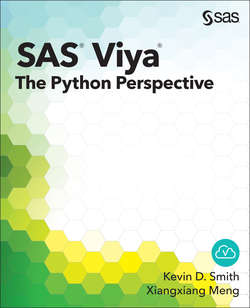SAS Viya

Реклама. ООО «ЛитРес», ИНН: 7719571260.
Оглавление
Kevin D. Smith. SAS Viya
Contents
Foreword
About This Book. What Does This Book Cover?
Is This Book for You?
What Are the Prerequisites for This Book?
Scope of This Book
What Should You Know about the Examples?
Software Used to Develop the Book's Content
Example Code and Data
We Want to Hear from You
About These Authors
Chapter 1: Installing Python, SAS SWAT, and CAS
Installing Python
Installing SAS SWAT
Installing CAS
Making Your First Connection
Conclusion
Chapter 2: The Ten-Minute Guide to Using CAS from Python
Importing SWAT and Getting Connected
Running CAS Actions
Loading Data
Executing Actions on CAS Tables
Data Visualization
Closing the Connection
Conclusion
Chapter 3: The Fundamentals of Using Python with CAS
Connecting to CAS
Running CAS Actions
Specifying Action Parameters
Constructing Nested Action Parameters
Automatic Type Casting
Scalar Parameter to Dictionary Conversion
CAS Action Results
Using DataFrames
Checking the Return Status of CAS Actions
Working with CAS Action Sets
Details
Getting Help
Dealing with Errors
Using CAS Action Exceptions
Resolving CAS Action Parameter Problems
Handling Other Errors
SWAT Options
Partial Option Name Matches
The swat.options Object
CAS Session Options
Conclusion
Chapter 4: Managing Your Data in CAS
Overview
Getting Started with Caslibs and CAS Tables
Loading Data into a CAS Table
Displaying Data in a CAS Table
Computing Simple Statistics
Dropping a CAS Table
CAS Data Types
Caslib and CAS Table Visibility
The Active Caslib
Uploading Data Files to CAS Tables
Uploading Data from URLs to CAS Tables
Uploading Data from a Pandas DataFrame to a CAS Table
Using Data Message Handlers
The HTML Data Message Handler
The Excel Data Message Handler
The PandasDataFrame Data Message Handler
Using Data Message Handlers with Databases
Streaming Data from a Database into a CAS Table
Writing Your Own Data Message Handlers
Variable Definition Details
Adding Data Transformers
Managing Caslibs
Creating a Caslib
Setting an Active Caslib
Dropping a Caslib
Conclusion
Chapter 5: The CASAction and CASTable Objects
Getting Started with the CASAction Objects
Setting Nested Parameters
Setting Parameters as Attributes
Retrieving and Removing Action Parameters
First Steps with the CASTable Object
Manually Creating a CASTable Object
CASTable Action Interface
Setting CASTable Parameters
Managing Parameters Using the Method Interface
Managing Parameters Using the Attribute Interface
Materializing CASTable Parameters
Conclusion
Chapter 6: Working with CAS Tables
Using CASTable Objects like a DataFrame
CAS Table Introspection
Computing Simple Statistics
Creating Plots from CASTable Data
Exporting CASTables to Other Formats
Sorting, Data Selection, and Iteration
Fetching Data with a Sort Order
Iterating through Columns and Rows
Basic Iteration
Iterating over Columns
Techniques for Indexing and Selecting Data
Selecting Columns by Label and Position
Selecting Data by Label and Position
Dynamic Data Selection
Data Wrangling on the Fly
Creating Computed Columns
By Group Processing
Concatenating By Groups
Selecting Result Keys by Table Name
Selecting a Specific By Group
Handling Multiple Sets of By Groups
Conclusion
Chapter 7: Data Exploration and Summary Statistics
Overview
Summarizing Continuous Variables
Descriptive Statistics
Histograms
Percentiles
Correlations
Summarizing Categorical Variables
Distinct Counts
Frequency
Top K
Cross Tabulations
Variable Transformation and Dimension Reduction
Variable Binning
Variable Imputation
Conclusion
Chapter 8: Modeling Continuous Variables
Linear Regressions
Extensions of Ordinary Linear Regression
Generalized Linear Models
Regression Trees
Conclusion
Chapter 9: Modeling Categorical Variables
Logistic Regression
Decision Trees
Gradient Boosting, Forests, and Neural Networks
Conclusion
Chapter 10: Advanced Topics
Binary vs. REST Interfaces
The Binary Interface
The REST Interface
The Pros and Cons of Each Interface
Binary (CAS) Interface
REST Interface
Result Processing Workflows
The Easy Way
Using Response and Result Callback Functions
Handling Responses from Multiple Sessions Simultaneously
Connecting to Existing Sessions
Communicating Securely
Conclusion
Appendix A: A Crash Course in Python
IPython and Jupyter
Data Types and Collections
Numeric Data Types
Character Data Types
Booleans
Lists and Tuples
Slicing
Tuples
Dictionaries and Sets
Sets
Other Types
Flow Control
Conditional Code
Looping
While Loops
For Loops
Loop Controls
Looping Helper Functions
Functions
Constructing Arguments Dynamically
Classes and Objects
Exceptions
Context Managers
Using the Pandas Package
Data Structures
Data Selection
The loc and iloc DataFrame Accessors
The at and iat DataFrame Accessors
The ix DataFrame Accessor
Using Boolean Masks
Creating Plots and Charts
Plotting from Pandas DataFrame Methods
Plotting DataFrames with Plotly and Cufflinks
Creating Graphics with Matplotlib
Interactive Visualization with Bokeh
Conclusion
Appendix B: Troubleshooting
Software Version Issues
Connection Issues
Missing Linux Library Dependencies
Incorrect SAS Threaded Kernel Configuration
Unable to Import _pyXXswat
Refused Connection
Authentication Problems
Index
Contents
Отрывок из книги
Foreword
About This Book
.....
+ Elapsed: 0.000494s, mem: 0.0546mb
The object that is held in the out variable is an instance of a Python class called CASResults. The CASResults class is a subclass of collections.OrderedDict. This class is a dictionary-like object that preserves the order of the items in it. If you want only a plain Python dictionary, you can convert it as follows, but you lose the ordering of the items.
.....